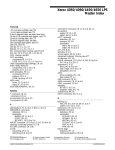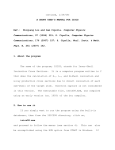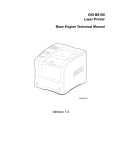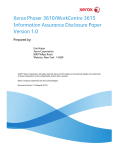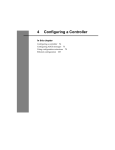Download Guardian Manuals - Guardian Telecom Inc.
Transcript
Talk Back Intercom System Model TBA Installation & Operation P007143 Rev. D 150824 8/24/2015 11:32 AM Ph: 403.258.3100 \ email:[email protected] \ www.guardiantelecom.com Guardian Telecom Inc. Installation & Operation TBA Models Contents 1. Purpose...............................................................................................4 2. Scope ..................................................................................................4 3. Identification of equipment ..................................................................4 3.1. TBA Model Numbering ..............................................................4 3.2. TBA Front Panel ........................................................................5 3.3. TBA Rear Panel.........................................................................5 3.4. TBA Enclosure Inside ................................................................6 4. System Overview ................................................................................7 4.1. Central Station ...........................................................................7 4.2. Monitored Station.......................................................................7 4.3. Stations #1, #2 and #3...............................................................7 4.4. PTT Actions ...............................................................................8 4.5. Alert or Go-Ahead Tone.............................................................8 4.6. Applications on Drilling Rigs ......................................................8 4.7. Applications on Shipboard .........................................................8 5. Application Restrictions.......................................................................8 6. Installation Instructions........................................................................9 6.1. TBA Enclosure...........................................................................9 6.2. AC Supply..................................................................................9 6.2.1. 230 VAC operation .............................................................9 6.2.2. DC Supply Options .............................................................9 6.3. Push to Talk Switches .............................................................10 6.4. Microphone ..............................................................................10 6.5. Speaker ...................................................................................10 7. TBA Configurations except for TBA-33 .............................................11 8. TBA-33 Configuration........................................................................13 9. Installation Adjustments ....................................................................19 9.1. Initial Settings ..........................................................................19 9.2. Powering ON the TBA .............................................................20 9.3. Monitored Station Microphone Volume Adjustment.................20 9.4. Central Station Microphone Volume Adjustment .....................20 9.5. Ringer Volume Adjustment ......................................................20 9.6. Central Station Speaker Volume .............................................20 9.7. Station #1 Speaker Volume .....................................................20 9.8. Station #2 Speaker Volume .....................................................20 9.9. Station #3 Speaker Volume .....................................................20 9.10. Optional Hum Cancellation ......................................................20 9.11. Optional ringing from PTTs......................................................21 9.12. Replace the TBA enclosure top panel .....................................21 10. Locations of adjustments for the TBA ...............................................21 10.1. Audio transformer tap adjustments..........................................21 11. Product Specifications.......................................................................22 Page 2 Guardian Telecom Inc. Installation & Operation TBA Models 12. Replacement Parts............................................................................23 13. Warranty............................................................................................24 14. Disclaimer .........................................................................................24 15. Warning.............................................................................................24 16. Service Telephone Number 1-800-363-8010...................................24 17. Feedback ..........................................................................................24 18. Guardian Product Return ..................................................................25 Figures Figure 1 - Table of TBA Models .................................................................4 Figure 2 – TBA-41 Front Panel ..................................................................5 Figure 3 – TBA-41 Rear Panel...................................................................5 Figure 4 - TBA Enclosure Inside Front.......................................................6 Figure 5 - TBA Enclosure Inside Rear .......................................................6 Figure 6 - TBA External Audio Connections ............................................11 Figure 7 - TBA Internal Audio Connections..............................................12 Figure 8 - TBA-33 Internal Audio Connections to 2011 ...........................13 Figure 9 - TBA-33 Internal Transformer Wiring Pre 2011 ........................14 Figure 10 - TBA-33 Internal Audio Connections Starting 2012 ................15 Figure 11 - TBA-33 Internal Transformer Connections ............................16 Figure 12 - Station Connector Wiring.......................................................17 Figure 13 - Central Station Microphone Wiring ........................................17 Figure 14 - Central Station Speaker Wiring .............................................18 Figure 15 - Adjustment Locations ............................................................21 Package Contents (1) TBA Talk Back Amplifier (1) Loudspeaker Additional Loudspeakers (optional – up to four) (1) Optional Central Station Microphone (except for model TBA-22) (1) Installation & Operation Manual Acronyms: TBA PWB PWBA AC DC KHz Hz Talk Back Amplifier Printed Wiring Board Printed Wiring Board Assembly Alternating Current Direct Current Thousand Hertz Cycles per second Page 3 Guardian Telecom Inc. 1. Installation & Operation TBA Models Purpose This document is provided to assist in the electrical installation and operation of a Talk Back Amplifier (TBA) as produced by Guardian Telecom Inc. 2. Scope The installation information will consist of connections to the TBA unit in the enclosure. The connections to external speakers and microphones are covered in their respective manuals. The operation information will consist of adjustment of potentiometers and power supply requirements for the TBA unit. Some information for the speaker and microphone sensitivity that relates to the TBA operation will be given to assist in the selection and installation of TBA peripherals. 3. Identification of equipment There are several models of Guardian Talk Back Amplifiers (TBA). The Printed Wiring Board Assembly (PWBA) in the TBA will support up to five speaker outputs; therefore the listing of equipment goes from five speaker outputs to two speaker outputs. 3.1. TBA Model Numbering The table below uses “CEN” for Central Station, “MON” for Monitored Station and #1 to #3 for Stations #1 to #3. The “X” in a square indicates that the speaker amplifier is populated on the PWBA. The “L” indicates low impedance and the “H” indicates high impedance. Figure 1 - Table of TBA Models Note: The Central Station input for the microphone on TBA-33 is modified to have an impedance of near 1K Ohm when the PTT is not pressed. See the section titled “Microphone” for further information. Page 4 Guardian Telecom Inc. 3.2. Installation & Operation TBA Models TBA Front Panel The TBA Front Panel of the enclosure has from two to five volume controls and a power indicator. The power indicator shows the presence of AC power, and is a green illumination if AC is present. The volume controls are labeled for the Station being controlled. Clockwise rotation gives more volume, the volume controls have numbers from1 to 10 to assist in setting repeatability. Figure 2 – TBA-41 Front Panel 3.3. TBA Rear Panel The TBA Rear Panel of the enclosure has from two to five cable entries, an AC power connector, an AC fuse and a Power ON/OFF switch. The AC power connector is a standard connector for AC supplies. The AC fuse is a 1 amp slow blow 250 volt fuse of 1.25” long and 0.25” diameter. Buss fuse type MDL 1A is supplied with the TBA. The POWER ON/OFF switch is a rocker switch; pushing the switch upwards turns on the TBA. Figure 3 – TBA-41 Rear Panel Page 5 Guardian Telecom Inc. 3.4. Installation & Operation TBA Models TBA Enclosure Inside The photos below show the TBA-50 with the top cover removed. Figure 4 - TBA Enclosure Inside Front Figure 5 - TBA Enclosure Inside Rear Page 6 Guardian Telecom Inc. 4. Installation & Operation TBA Models System Overview The Talk Back Amplifier (TBA) is so named because of the ability for the user to talk back to the speakers instead of using a separate microphone to talk back. The model TBA is an intercom system designed for use in situations where frequent communications between two or more stations are required. The TBA system utilizes speakers in two modes: as a speaker output to broadcast audio messages from other stations as an audio microphone to pick up audio messages. 4.1. Central Station The Central Station speaker normally outputs audio coming from the Monitored Station. The audio from the Monitored Station or Stations #1, #2 or #3 with their PTT depressed, will be output on the Central Station speaker. To output audio the Central Station user presses the Press to Talk (PTT) switch. The Central Station PTT switch is normally mounted on the microphone housing, but it may be a foot switch. The Central station is different from the other stations in that it has a separate microphone input as well as a speaker output. The Central Station speaker also has a low level “sidetone” audio from the speaker to allow the user to hear that the Central Station audio output is working. The Central Station console consists of a (goose neck) dynamic microphone and a hand switch or pedal switch for PTT. The Central Station has the highest priority in using PTT. When the Central Station PTT switch is engaged (depressed) the TBA puts a low level audio onto the Central Station speaker. This low level is to prevent acoustical feedback. The other speakers in the system are set to the speaker mode and output audio coming from the Central Station. 4.2. Monitored Station The Monitored Station is different from the other stations in that it will continuously send the audio heard at its speaker to the other stations when no Press to Talk (PTT) switch in the TBA is depressed. The Central Station and up to three stations normally output audio coming from the Monitored Station to their speakers. The PTT switch on the Monitored Station is used only as a “Ringing” or Alert Tone activation. Pressing the Monitored Station PTT will stop the audio output from the Monitored Station and put a “Ringing” tone onto the Central Station, Monitored Station and the other stations’ speakers. The Monitored Station speaker will output the audio coming from another station if the other station presses a PTT switch. When the Monitored Station speaker is outputting audio it does not send audio to the other stations. The Monitored Station speaker will change from a microphone input into a speaker output when the Central Station or another station has the PTT switch pressed. 4.3. Stations #1, #2 and #3 The Stations #1, #2 and #3 have a speaker and a PTT switch. The audio from the Monitored Station or any other station with a PTT depressed will be output on that station’s speaker. When the station’s PTT switch is depressed the station will output audio to the other stations. When the speaker is outputting audio it does not receive audio from the other stations. Page 7 Guardian Telecom Inc. 4.4. Installation & Operation TBA Models PTT Actions The Central Station Push to Talk (PTT) switch has the highest priority in using PTT. When the PTT is pressed on the Monitored or Stations #1, #2 or #3 the stations are a first-come first-served basis for PTT. When the PTT switch on the Monitored Station is pressed the other speakers on the system will output a “ringing” tone for as long as the PTT is pressed. When the PTT switch on the Central Station, Stations #1, #2 or #3 is pressed the system will use the speaker on that station to generate audio for the other station speakers. 4.5. Alert or Go-Ahead Tone The Talk Back Amplifier (TBA) has a tone generator that sounds similar to a telephone ringing. This dual tone (“Ringing”) is generated for two purposes: Alert Go-Ahead The Alert Tone or “Ringing” is caused by the Monitored Station pushing the Push to Talk (PTT) switch. The Go-Ahead short “Ringing” is a 0.1 second long sound burst that indicates to the users that a PTT switch has just been released on the Central Station or Station #1, #2 or #3. This Go-Ahead indicates that the other station has ceased pressing the PTT switch and that normal operation can be resumed. When this post announcement short “Ringing” tone is heard it confirms to the listener that the system is in the receive mode. Jumper JP1 on the Printed Circuit Board Assembly (PCBA) is a switch to allow the injection of the post PTT Go-Ahead or short “Ringing” tone. Moving JP1 to the bottom set of terminals will disable the Go-Ahead or short “Ringing” tone. 4.6. Applications on Drilling Rigs In drilling rig applications the TBA normally consists of: Central Station at the doghouse with a speaker and microphone Monitored Station at the monkey board Station #1, #2 and #3 as needed. The monkey board or racking board for the derrick man is up on the drilling rig tower, and the derrick man’s instructions to the dog house (driller’s communication shack) should be continuously monitored. 4.7. Applications on Shipboard Audio monitoring of the wheelhouse or control station can be used to inform the engine room and other stations of the actions needed to be performed. In this way commands for ship operation can be communicated without delay by the ship operator simply speaking. The telephone intercom on board the ship is connected to a special impedance of the Central Station made for the 600 Ohm telephone system. A PTT from the telephone line is used to activate the output to the talk back speakers both FORE and AFT. After the PTT the FORE and AFT can reply back to the telephone system by talking to the speakers. The period for the FORE and AFT stations to talk back after a PTT is received from the telephone interface is selected by a jumper on Monitored Station PTT for 1 minute, or a jumper on Station #1 PTT for 10 minutes. 5. Application Restrictions The Talk Back Amplifier (TBA) enclosure is not approved for use in hazardous areas. The Central Station console microphone (as supplied) is not approved for use in hazardous areas. A microphone may be used in hazardous areas if it is connected through an approved intrinsically safe barrier. Page 8 Guardian Telecom Inc. Installation & Operation TBA Models The Push to Talk (PTT) switches may be of a suitable rating for use in hazardous areas, or connected through an approved intrinsically safe barrier. Any application of equipment into a hazardous area must be approved by the appropriate authority. The speakers used may be of a suitable rating for use in hazardous areas. The speakers used with the system may or may not be approved, check the labels on the speakers for ratings. Follow all local codes and requirements when installing the TBA Intercom System. The TBA does not have a weatherproof or drip-proof rating, and is not protected for prolonged exposure to high humidity and salt fog. 6. Installation Instructions The Talk Back Amplifier (TBA) is an audio amplifier that has been designed to operate in a commercial setting. In order to obtain the best results, use shielded cable and follow the instructions below. 6.1. TBA Enclosure The TBA enclosure houses the Printed Wiring Board Assembly (PWBA) within a steel enclosure that has a removable top cover. A wiring diagram is on the inside of the cover. The enclosure may be placed on a flat surface, mounted in an equipment rack or otherwise securely mounted. The TBA enclosure can dissipate up to 110 watts with all of the speaker amplifiers outputting maximum energy. There must be adequate heat conduction so that the enclosure does not exceed 20 deg above ambient with 110 watts dissipation. An air flow caused by convection with a 1 inch gap to surrounding side walls is normally adequate. If in doubt, test the temperature rise using a heater of 100 watts in the case and measure the resultant temperature after 1 hour. The TBA enclosure top panel may be removed by unfastening the six screws. Once the top panel has been removed, access to 120 volts AC is provided; therefore the service personnel should be qualified to work with electrical equipment. The TBA amplifier enclosure is painted and uses stainless steel hardware internally. The components within the enclosure are not waterproof or corrosion resistant so the enclosure should not be used in a corrosive or contaminated environment. 6.2. AC Supply The Talk Back Amplifier uses 120 VAC at 60 Hz with a maximum of 1 amp continuous current for energy supply. Note that the inrush current may be up to 10 amps for a fraction of a second. There is an inrush surge reduction circuit that reduces the capacitive charging surge on power-on. This circuit can be evaluated for inrush surge reduction if there is a problem with the external 120 volt power current surge capability. 6.2.1. 230 VAC operation A 230 VAC to 24 VAC transformer can be special ordered for the TBA. The input voltage labeling and serial number label must be changed or marked to indicate this change. The front panel Power ON indicator must also be changed for 230 VAC operation. 6.2.2. DC Supply Options The use of a separate DC supply for 27 to 35 volts (0.5 amps maximum) is possible to replace the internal supply of the TBA logic and preamplifier sections for supply to J22 pins 1 and 3. The negative ground connection is available at J22 pin 3 and positive is attached to J22 pin 1. The use of a separate 30 to 70 volt supply (10 amps maximum) can be applied separately for the audio power amplifiers if the jumper on J22 pin 1 to 2 is removed. The negative ground connection is available at J22 pin 3. If this option is used, the internal transformer for 8 to 325 Ohms is to be removed and the amplifier will drive the 70 volt line directly. Note that the DC supply generated within the TBA is “floating” with respect to the chassis ground. Verify that the negative at J22 pin 3 (PWBA ground) has a low voltage and low audio frequency noise with respect to chassis ground if there is noise present on the Talk Back Amplifier system. Page 9 Guardian Telecom Inc. 6.3. Installation & Operation TBA Models Push to Talk Switches The Talk Back Amplifier has a 24 volt resistive connection to Push to Talk (PTT) switches. The use of gold or silver plated switch contacts within an environmentally sealed housing is recommended for long term reliability. The switches will conduct about 0.5 milliamp when pressed, and have 24 volts across the terminals when not pressed. Each of these connections should be evaluated separately for safety. 6.4. Microphone For all of the models except the TBA-33 the microphone input is terminated with a low impedance of less than 10 Ohms at 1 KHz when the Central Station PTT is not pressed. The TBA-33 has a 1K Ohm impedance across its terminals when the Central Station PTT is not pressed. There is no DC supply or bias applied to the microphone line pair as the microphone input is optimized for a dynamic microphone. The level on the microphone is -80 dB reference 1 volt per bar (0.1 millivolt per bar). This is 0.1 millivolt from 150 Ohms series impedance with a 94 dB SPL activation. EIA sensitivity is -152 dB. The Telex 785L is one microphone type that meets this specification. The connection to the microphone is a two wire shielded cable, with the shield terminated at the TBA enclosure only. Ensure the microphone cable is not routed near a source of interference such as a generator, high voltage cable or AC supply transformer. Each of these connections should be evaluated separately for safety. 6.5. Speaker The Talk Back Amplifier has a 10 watt at 325 ohm audio output to the speakers. This is also known as a 70 volt intercom system. The speakers used should be transformer coupled to the acoustic transducer. The acoustic transducer may be a cone type speaker or a compression driver with an expansion cone. The compression driver type of speaker is about 6 dB more efficient than a cone speaker for sound input to electrical output when it used as a microphone. The speaker on the Monitored Station and Stations #1, #2 and #3 are used as audio input devices. The level of audio from these speakers is near 1 millivolt for 94 dB SPL at 1 foot from the front of the speakers. Different types of speakers will have different sensitivities and the user must evaluate the performance of the speaker when at the location. The transformer on the speaker is capable of picking up surrounding magnetic fields, especially from a 60 Hz transformer nearby. Ensure that the speakers and transformers are separated from AC supply transformers and other sources of magnetic fields. The connection to the speaker is a two wire shielded cable, with the shield terminated at the TBA enclosure only. Ensure the speaker cable is not routed near a source of interference such as a generator, high voltage cable or AC supply transformer. Each of these connections should be evaluated separately for safety. Page 10 Guardian Telecom Inc. Installation & Operation TBA Models 7. TBA Configurations except for TBA-33 The external and internal connections for the TBA’s audio connections are shown in block form below. Note that the connections of Stn #1, #2 and #3 are the same as for the Monitored (Mon) station. Stations #1, #2 and #3 are connected in the same manner as the Monitored Station shown below. Figure 6 - TBA External Audio Connections Page 11 Guardian Telecom Inc. Installation & Operation TBA Models The 8 Ohm to 325 Ohm transformer is called a “70 volt transformer”, and it connects between the output amplifier and the speaker. Stations #1, #2 and #3 are connected in the same manner as the Monitored Station shown below. Figure 7 - TBA Internal Audio Connections Page 12 Guardian Telecom Inc. Installation & Operation TBA Models 8. TBA-33 Configuration The connections for the TBA-33 PWBAs before 2012 are shown below. The 8 Ohm to 325 Ohm transformer is called a “70 volt transformer”, and it connects between the output amplifier and the speaker. Figure 8 - TBA-33 Internal Audio Connections Pre 2012 Page 13 Guardian Telecom Inc. Installation & Operation TBA Models Figure 9 - TBA-33 Internal Transformer Connections Pre 2012 Page 14 Guardian Telecom Inc. Installation & Operation TBA Models The connections for the TBA-33 PWBAs starting in 2012 are shown below. Note that the value of R161 is 10 K Ohm and R166 is 1.0 K Ohm to reduce the input gain to telephone line levels. The transformer on the Central Station output is a 600 to 10K Ohm transformer to raise the impedance from 8 Ohms to 150 Ohms in order to be closer to the impedance of a microphone input to a telephone line adaptor module. Figure 10 - TBA-33 Internal Audio Connections Starting 2012 Page 15 Guardian Telecom Inc. Installation & Operation TBA Models Figure 11 - TBA-33 Internal Transformer Connections Starting 2012 Page 16 Guardian Telecom Inc. Installation & Operation TBA Models Figure 12 - Station Connector Wiring Figure 13 - Central Station Microphone Wiring Page 17 Guardian Telecom Inc. Installation & Operation TBA Models Figure 14 - Central Station Speaker Wiring Page 18 Guardian Telecom Inc. 9. Installation & Operation TBA Models Installation Adjustments The speaker outputs levels are each individually adjustable. The gain for the Central Station microphone is adjustable. The gain for the Monitored Station, Station #1, #2, and #3 are on one adjustment. Remove the TBA enclosure top panel by unfastening the six screws; retain the screws and panel. Once the top panel has been removed, access to 120 volts AC is provided; therefore the service personnel should be qualified to work with electrical equipment. 9.1. Initial Settings These settings are to be done before powering the TBA “on” for the first time. If previous adjustments have been made, note the front panel adjustment positions or mark them on the internal PWBA potentiometers. Refer to Figure 15 - Adjustment Locations for the locations of the following adjustments. Adjust these potentiometers to the 50% rotation point: Central Station Volume (R11) Monitored Station Volume (R141) Station #1 Volume (R47) Station #2 Volume (R79) Station #3 Volume (R110) Central Station Volume (Microphone – R183) Stations 1 to 3 and Monitored Station Volume (Microphone – R184) Ring Volume (R186) As well the following settings are to be done. Adjust Central Station Attenuation (R12) to fully counterclockwise JP1 to “Ring Enable” JP2 to “nearest pair to R180 J21 jumper on 1 to 2 (CENTRAL RELAY) J21 jumper on 5 to 6 (MONITORED RELAY) J21 jumper on 9 to 10 (STN #1 RELAY) J21 jumper on 13 to 14 (STN #2 RELAY) J21 jumper on 17 to 18 (STN #3 RELAY) Verify the jumpers on J21 are only those shown above unless special instructions are given for “RINGING” settings. Page 19 Guardian Telecom Inc. 9.2. Installation & Operation TBA Models Powering ON the TBA Turn the AC power switch on the back panel to “ON”. Verify that the “Go-Ahead” tone is heard briefly on all of the speakers attached. 9.3. Monitored Station Microphone Volume Adjustment Monitored Station Volume (Microphone – R184) adjustment is done while listening to the output of the audio on the speaker for another station. With a sound source that is expected to be near the maximum level adjust R184 so that the sound is just starting to be distorted. Alternatively adjust R184 so the signal on J15 pin 1 is at 0.1 volts RMS with a normal voice level. Alternatively adjust R184 so that it is at 25% of the rotation clockwise. 9.4. Central Station Microphone Volume Adjustment Press the Central Station PTT switch. Adjust the Central Station Volume (Microphone – R183). Adjustment is done while listening to the output of the audio on the speaker for another station. With a sound source that is expected to be near the maximum level adjust R183 so that the sound is just starting to be distorted. Alternatively adjust R183 so the signal on J15 pin 1 is at 0.1 volts RMS with a normal voice. Alternatively adjust R183 so that it is at 50% of the rotation clockwise. 9.5. Ringer Volume Adjustment Press the Monitored Station PTT switch. Adjust the Ring Volume (R186) to have a ringing signal that is loud enough but does not distort. Alternatively adjust R186 so the signal on J15 pin 1 is at 0.2 volts RMS. Alternatively adjust R186 so that it is at 50% of the rotation clockwise. 9.6. Central Station Speaker Volume Adjust Central Station Volume (R11) so that the voice from the Monitored Station is at a comfortable level for the Central Station operator. 9.7. Station #1 Speaker Volume Adjust Station #1 Volume (R47) so that the voice from the Monitored Station is at a comfortable level for the Station #1 operator. 9.8. Station #2 Speaker Volume Adjust Station #2 (R79) so that the voice from the Monitored Station is at a comfortable level for the Central Station operator. 9.9. Station #3 Speaker Volume Adjust Station #3 Volume (R110) so that the voice from the Monitored Station is at a comfortable level for the Station #3 operator. 9.10. Optional Hum Cancellation The jumper on JP2 should be removed and replaced. If the sound level of the background noise or hum changes with this action, replace JP2 jumper to the location nearest R180. If the sound does not change replace JP2 jumper to the location away from R180 and do not adjust R179. Adjust R179 for the minimum noise from a station speaker. This is a subjective adjustment. Page 20 Guardian Telecom Inc. Installation & Operation TBA Models 9.11. Optional ringing from PTTs The PTTs inputs can be used to operate the speaker as a microphone with the jumpers on J21 at the “RELAY” position. The PTTs can also be used to directly activate the “Ringer” output with a jumper on J21 at the “RINGING” position for that station. As all of the stations PTT input circuitry locations are populated on the PCBA, it is possible to add extra “Ringer Switches” at unused station PTT locations without affecting the operation of the Talk Back Amplifier system. To prevent the “RINGER” switch from interfering with normal PTT action when it being used as a “Ringer”: remove the jumper on J21 for “RELAY” on any position used as a “RINGER” input. 9.12. Replace the TBA enclosure top panel Turn the AC Power Switch to OFF. Mark the potentiometer positions with a marker on the PWBA mounted adjustments. Note the front panel Volume control positions or numbers for future use. Replace the TBA enclosure top panel using the six screws removed earlier. 10. Locations of adjustments for the TBA The sketch below gives the approximate locations of the adjustments for the TBA. These adjustment locations are also labeled on the TBA. Figure 15 - Adjustment Locations 10.1. Audio transformer tap adjustments The audio output transformers are all connected with 0 and 8 Ohms on the input and COM and 325 Ohms on the output for normal operation. If these positions are changed, mark the transformer top with a large label to caution other installers that these are not standard connections. Page 21 Guardian Telecom Inc. Installation & Operation TBA Models 11. Product Specifications Electrical POWER REQUIREMENT 120VAC @ 60 HZ POWER SUPPLY FUSE 250V, 1.0A, SLOW BLOW, 1AG OPTIONAL POWER SUPPLIES 230V@ 50/60 HZ OR 30 VDC 10A EXTERNAL POWER Audio And Control Inputs CONSOLE MICROPHONE INPUT AND CONTROL AUDIO: 150 OHMS DYNAMIC MICROPHONE PTT SWITCH: DRY CONTACT SPST PRIMARY SPEAKER WHEN USED AS A TALK BACK MICROPHONE AUDIO: 350 OHMS 1 MILLIVOLT RMS NOM, 1 VOLT MAX PTT SWITCH: DRY CONTACT SPST ADDITIONAL SPEAKERS WHEN USED AS TALK BACK MICROPHONES AUDIO: 350 OHMS 1 MILLIVOLT RMS NOM, 1 VOLT MAX PTT SWITCH: DRY CONTACT SPST Audio Outputs CONSOLE CHANNEL 325 OHMS (70V) LINE, 10 W PRIMARY SPEAKER CHANNEL 325 OHMS (70V) LINE, 10 W CHANNELS 1,2 & 3 (TBA30/40/50) 325 OHMS (70V) LINE, 10 W Mechanical DIMENSIONS (H X W X D) 5 X 16.5 X 12 INCHES (127 X 419 X 305 MM) NET WEIGHT 20 POUNDS (9 KG) STANDARD MOUNTING HORIZONTAL WIRING ACCESS CABLE GLANDS HARDWARE MATERIAL STAINLESS STEEL Page 22 Guardian Telecom Inc. Installation & Operation TBA Models 12. Replacement Parts Part No. Description P001626 Fuse Holder P002843 Transformer 10 Pin 70.7/25V P003061 Transformer 24V Hammond - 167L24 P004078 Fuse - 1 Amp Slo-Blow Glass P004833 Switch - Rotary Cap Pointer Black P004851 Switch - Faceplate Snap In Rocker White P005123 Label Volume Control Plate P005995 Neon Lamp - 120VAC P006322 Volume Control Switch Assembly P006697 Connector - Universal Snap-In Inlet P006698 Cord - Detachable Power Cord P005521 PCBA - TBA50 P005882 PCBA - TBA20 P005991 PCBA - TBA30 P005998 PCBA - TBA40 P006145 PCBA - TBA41 P006146 PCBA - TBA31 P006147 PCBA - TBA21 P007142 PCBA - TBA33 P007385 PCBA - TBA22 Page 23 Guardian Telecom Inc. Installation & Operation TBA Models 13. Warranty Guardian Telecom warrants your product to be free of defects in material and workmanship for a period of one year. Guardian Telecom will repair or replace any defective unit that is under warranty free of charge. This warranty is null and void if any non-authorized modifications have been made to this product, or if it has been subjected to misuse, neglect, or accident. This warranty covers bench repairs only; such repairs must be made at Guardian Telecom or an authorized service depot. Guardian Telecom is not responsible for costs incurred for on-site service calls, freight, or brokerage. A return authorization must be obtained prior to warranty claims or repairs. 14. Disclaimer The products covered by this manual are designed for use in Industrial Environments and/or Hazardous Locations. Due to the range of possible applications for these instruments the manufacturer will not be responsible for damages or losses of any kind suffered as a result of the use of this product, including consequential damages. 15. Warning This device may be opened and reassembled by qualified personnel only, for the purposes of installing the product, making adjustments and replacing components, following the instructions in the product manual. High voltages may be present in this product when connected to system wiring. 16. Service Telephone Number 1-800-363-8010 Guardian Telecom provides a customer service telephone number which is toll-free within North America. If you need assistance when installing or operating this product, please call the toll-free telephone number between regular business hours (8:00AM-5:00PM), Mountain Standard Time. If you are calling outside of regular business hours, please leave a detailed message, and a member of Guardian Telecom’s Service Department will return your call as soon as possible. If your product requires service, Guardian personnel will supply you with an RMA (return materials authorization) number over the telephone or through our web site product return page. This number must be included with your return address and the name of the person to contact. Guardian Telecom Inc. Toll-free 1-800-363-8010 Ph. (403) 258-3100 Fax. (403) 253-4967 www.guardiantelecom.com 17. Feedback Guardian Telecom continually strives to make reliable, durable, and easy to use products. If you, as an installer or user of our equipment, have any suggestions for improvements to this or any of our products or documents, including this manual, we would appreciate hearing from you. Page 24 Guardian Telecom Inc. Installation & Operation TBA Models 18. Guardian Product Return Guardian products have been quality tested and are in full working order when shipped from the factory, given the rugged nature of these products shipping is not expected to damage a unit. In the unlikely event of a malfunction Guardian follows the three step procedure below. Step I - On-Site Correction The most common source of difficulties with a new product is improper installation in one of two ways: incorrect wiring connections or connection to an incorrect power source. Product wiring needs to be properly connected to the on-site wiring. Correct wiring instructions are shown in the user manual included with the product. Step II - Return Materials Authorization (RMA) When a product has been installed following user manual instructions, and the unit fails to operate, the user must contact Guardian Telecom to obtain authorization to return the product. This can be done by completing a RMA form online at www.guardiantelecom.com, or by calling the service telephone number given in this manual. After providing information on the product, the owner and the nature of the problem, Guardian will issue a RMA number, to be shown on documentation returned with the product. In addition to the RMA number, shipping documents should include name, address and telephone number of the owner along with contact information for the person responsible for the repair and/or the user who identified the malfunction. (Where a product is being returned for repair from outside of Canada, customs documentation must show the product’s serial number, date of export [date of purchase], and a notation that the equipment is: “Canadian goods returning.”) Step III - Factory Authorized Service Once received, each product is carefully inspected and tested. If the product is under warranty, repairs are completed and the product returned to the owner, generally within five working days of receipt by the factory. A product that has been subjected to misuse, neglect or accident or is beyond the warranty period will be evaluated. The service department will provide the owner’s representative with a repair cost estimate. Once approved, repairs are completed and the product returned, generally within five working days. Page 25 Guardian Telecom Inc. Installation & Operation TBA Models Notes: Model No. Part No. Serial No. Date of Purchase Page 26 THIS PAGE INTENTIONALLY LEFT BLANK Guardian Telecom Inc. Toll-free 1-800-363-8010 Phone (403) 258-3100 Fax. (403) 253-4967 www.guardiantelecom.com E-mail: [email protected] CONNECTED. PROTECTED. © Guardian Telecom Inc. 2015




























